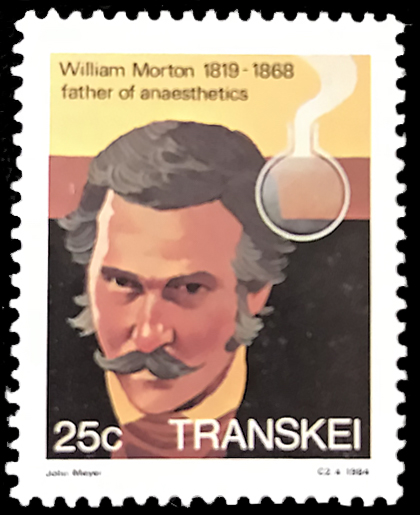William Morton (Transkei)
The Stamp
 This stamp was issued by the Republic of Transkei, in South Africa on 12 October 1984. It has a face value of 25 cents and it formed part of a series of famous physicians.
This stamp was issued by the Republic of Transkei, in South Africa on 12 October 1984. It has a face value of 25 cents and it formed part of a series of famous physicians.
The Doctor
William Morton was an American dentist and doctor who first publicly demonstrated the use of inhaled ether as an anaesthetic in 1846.
William Thomas Green Morton was born on 9 August 1819 in Charlton Massachusetts, the son of a miner. Initially working as a clerk, printer, and salesman, Mortin then studied at the Baltimore College of Dental Surgery. After marrying Elizabeth Whitman, the daughter of a Congressman, his in-laws objected to his profession so he studied medicine at Harvard (although he never qualified).
On 30 September 1846, Morton performed a painless tooth extraction on a patient using ether. After reading about this in the newspaper, the Boston surgeon, Henry Bigelow arranged a demonstration of ether on 16 October 1846 in the operating theatre of the Massachusetts General Hospital. A surgeon, John Collins Warren, painlessly removed a tumour from the neck of Edward Gilbert Abbott under an ether anaesthetic given by Morton. This was the first public demonstration of ether as an anaesthetic.
Ether had, however, been previously used successfully by Crawford Long in 1842, but he was slow to publish his work. Morton tried to patent ether, and also applied for recompense of $100,000 from Congress for his discovery; this was frowned upon by the medical profession as unethical.
Morton gave over 2000 ether anaesthetics to wounded soldiers during the American Civil War.
In July 1868, whilst riding in a carriage with his wife through Central Park, he suddenly leapt out and ran into the lake "to cool off". This was the first symptom of a major stroke from which he quickly died.
Urology Connections
The new medical "miracle" of ether anaesthesia spread quickly across the world. The first recorded ether anaesthetic administered outside the USA was on 19 December 1846 by the dentist James Robinson in Gower Street, London. Anaesthesia revolutionised urological surgery and helped surgeons like Spencer Wells pioneer laparotomy; this led to regular nephrectomy and open prostatectomy before the end of the 19th century.
← Back to Stamp Collection